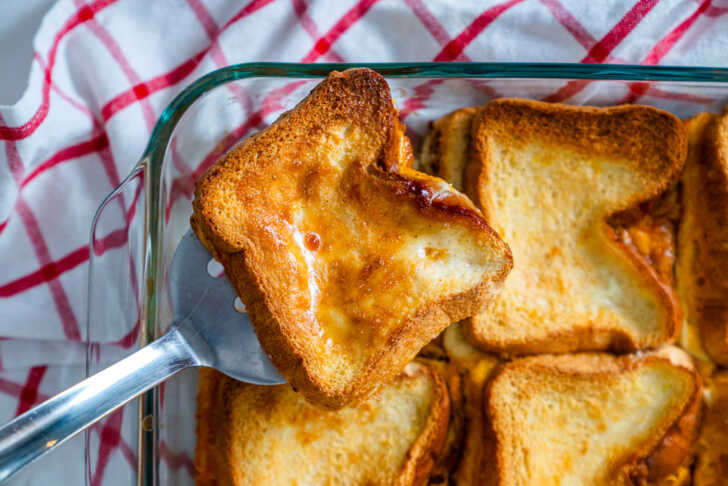 Pin it
Pin it
This vintage cheese sandwich casserole from Betty Crocker's 1950 cookbook transforms simple ingredients into a comforting, golden-brown delight that's perfect for brunch or a light dinner. The bread soaks up the savory custard while the cheese melts into gooey perfection between the layers.
I discovered this gem while cooking through my grandmother's cherished Betty Crocker Picture Cookbook. The first time I served it for a family brunch, my children were skeptical of this "sandwich casserole" but quickly requested seconds and now it's our Saturday morning tradition.
Ingredients
- White bread: Twelve slices create the foundation. Choose a quality sandwich bread that isn't too thin.
- Sharp cheddar cheese: Six slices provide rich flavor. Freshly sliced from a block melts more smoothly than pre-packaged.
- Egg yolks: Four yolks or two whole eggs give custard richness. Room temperature eggs incorporate better.
- Whole milk: Two and a half cups creates the perfect custard. The fat content is essential for proper texture.
- Salt: One teaspoon enhances all flavors. Kosher salt distributes more evenly.
- Black pepper: One eighth teaspoon adds subtle warmth. Freshly ground provides better flavor.
- Dry mustard: Quarter teaspoon complements the cheese. Authentic vintage touch that adds depth.
Step-by-Step Instructions
- Prepare the baking dish:
- Thoroughly grease a 9x13 baking dish with butter ensuring all corners are coated. This prevents sticking and adds flavor to the outer edges of the casserole.
- Create the sandwich layers:
- Arrange six bread slices evenly across the bottom of your greased dish. They should fit comfortably without much overlap. Place one slice of cheddar cheese on each bread slice, covering completely. Top with remaining bread slices to create six complete sandwiches.
- Mix the custard:
- In a large measuring cup or bowl with a spout, thoroughly whisk together egg yolks or whole eggs with milk until completely combined. Add salt, pepper, and dry mustard, whisking again until spices are fully incorporated. The mixture should be smooth and uniform in color.
- Pour and soak:
- Slowly pour the custard mixture over the sandwiches, making sure to distribute it evenly around the dish. Gently press down on the sandwiches to help them begin absorbing the liquid.
- Chill thoroughly:
- Refrigerate the assembled casserole until the bread has fully softened and absorbed most of the liquid, at least 30 minutes. Overnight soaking produces the best texture and allows flavors to fully develop.
- Bake to golden perfection:
- Preheat your oven to 350°F. Place the chilled casserole in the center rack and bake uncovered for approximately one hour until the top is beautifully golden brown and the center is set but still slightly jiggly.
- Rest before serving:
- Allow the casserole to rest for 10 minutes before serving. This allows the custard to fully set for easier slicing and serving.
My grandmother always said the dry mustard was her secret weapon in this recipe. She claimed it was what separated a good cheese casserole from a great one. When I make this now, I can picture her in her kitchen with her dog-eared cookbook, carefully measuring that quarter teaspoon of mustard powder with a knowing smile.
Modern Variations
While the original recipe has stood the test of time, modern palates might enjoy experimenting with additions like sautéed mushrooms, diced ham, or caramelized onions between the layers. You can also swap the cheddar for Gruyère, fontina, or a combination of cheeses for different flavor profiles. The basic formula remains foolproof no matter how you customize it.
Serving Suggestions
This casserole pairs wonderfully with a simple green salad dressed with vinaigrette to cut through the richness. For brunch, serve alongside fresh fruit or crispy bacon. I find that a small dollop of whole grain mustard or a light drizzle of maple syrup on top creates a delightful sweet and savory contrast that my guests always appreciate.
The History Behind The Dish
This casserole represents post-war American convenience cooking at its finest. The 1950s saw a boom in casserole recipes as they were economical, could feed a crowd, and made use of newly available processed foods. Betty Crocker became a household name by creating approachable recipes for homemakers. This particular dish exists in the sweet spot between comfort food and practical efficiency that defined that era of American cooking.
Storage and Reheating
Leftovers can be refrigerated for up to three days in an airtight container. To reheat, cover with foil and warm in a 325°F oven for about 15 minutes, removing the foil for the last few minutes to re-crisp the top. Individual portions can be microwaved for 1-2 minutes, though you'll lose some of the textural contrast this way.
Frequently Asked Questions
- → Can I use whole eggs instead of egg yolks?
Yes, you can use 2 whole eggs as a substitute for 4 egg yolks. This will work perfectly for the custard mixture.
- → What kind of cheese works best for this casserole?
Sharp cheddar is recommended for its rich flavor, but you can experiment with other cheeses like Gruyère or Monterey Jack.
- → Can I prepare this casserole ahead of time?
Yes, you can assemble the casserole, refrigerate it, and bake it when ready. Let it chill to soften the bread before baking.
- → What’s the best type of bread to use?
White sandwich bread is traditional for this dish, but you can try sourdough or whole wheat for a heartier texture.
- → How do I know when the casserole is done baking?
The casserole is done when the top is golden brown and the custard is set. You can insert a knife to check if it comes out clean.
- → Can I add other ingredients to this casserole?
Absolutely! You could add cooked bacon, ham, or sautéed vegetables like onions or spinach for extra flavor and texture.
